Updated 1 week ago
Bluetti solar generators expert review: choose the right one for you
Written by
Ben Zientara
Bluetti is a well-known brand that primarily makes portable solar generators, battery backup systems, and foldable solar panels. Their products use LiFePO4 battery technology, which is currently regarded as the best kind of lithium battery on the market and has proven quite popular in the DIY and "van life" communities, allowing people to power important devices and appliances in off-grid situations.
We’ve tested several of Bluetti’s solar generators and given them these grades:
Bluetti AC300+B300 combo: A+
Bluetti AC180: A
Bluetti EB55: B+
In general, we find Bluetti solar generators to be highly capable, reliable units. We like their build quality, long-term warranties, and wireless phone charging pads. Here's our video review of these Bluetti batteries:
Below, you’ll find more information on the Bluetti products we’ve tested and their uses.
Key takeaways
-
Bluetti solar generators use lithium iron phosphate (LiFePO4) battery technology that is safer and longer lasting than other designs of lithium batteries.
-
The company offers many battery products in capacities ranging from 268 watt-hours to a whopping 19.84 kilowatt-hours.
-
Most Bluetti batteries are portable and all come with the ability to charge from solar panels, which the company also makes.
-
The company offers warranties of 5 years for most of its smaller portable solar generators and up to ten years for its large home backup solutions.
-
With the wide range of options available, robust build quality, and great technology behind it all, SolarReviews recommends Bluetti products.
Bluetti’s technology
Bluetti’s key value proposition comes from its use of Lithium Iron Phosphate batteries. This combination of chemicals (LiFePO4, or LFP for short) makes Bluetti’s batteries more stable, longer lasting, and less environmentally harmful than typical lithium nickel manganese cobalt (NMC) batteries used by other popular solar generators. Bluetti says its LFP batteries can be cycled 2,500 (EB series) to 3,500 (AC and B series) times before being reduced to 80% of their original capacity, compared to other brands’ 500-cycle lifespan.
The next feature common to Bluetti's Portable Power Stations is solar input. From the entry-level EB3A to the flagship AC200P, comes with an MPPT solar charge controller built-in, allowing the battery to get the most from solar panels. Bluetti makes its own foldable solar panel, but also provides standard MC4 connections so any compatible solar array can be used to charge its batteries (with allowable input wattage that differs for each of its products).
Finally, Bluetti includes a pure sine wave inverter in each of its batteries and provides multiple DC and AC outlets to provide options for powering devices. Typical outlets include USB-A, USB-C, 120V AC, and 12V DC. In addition, all Bluetti Portable Power Stations come with 15W wireless charging pads built into the top of the unit.
Bluetti solar generator reviews
In order to provide a good review of Bluetti’s Portable Power Stations, we purchased a Bluetti EB55 along with a PV120 foldable solar panel. We’ve also received testing samples of some of Bluetti’s larger power stations, including the AC180 and AC300+B300 combo. More on these below.
Bluetti EB55 and PV120 solar panel
We found the EB55 and PV120 to be well-built, capable and versatile pieces of equipment. They are an excellent option for people who need power on the go, whether it's in an off-grid camping setting, as an RV accessory, or even just a fun day at the park or beach.
With this pair of products, you can provide power to numerous devices away from home, and even provide yourself some peace of mind in the event of a power outage.
The EB55 has 537 watt-hours (Wh) of storage capacity and can output 700W of continuous power (1,400W surge). That’s not enough power to start an air conditioner, but it is enough to run a full-sized refrigerator for a few hours during a power outage, or several smaller appliances for a full day, even without recharging.
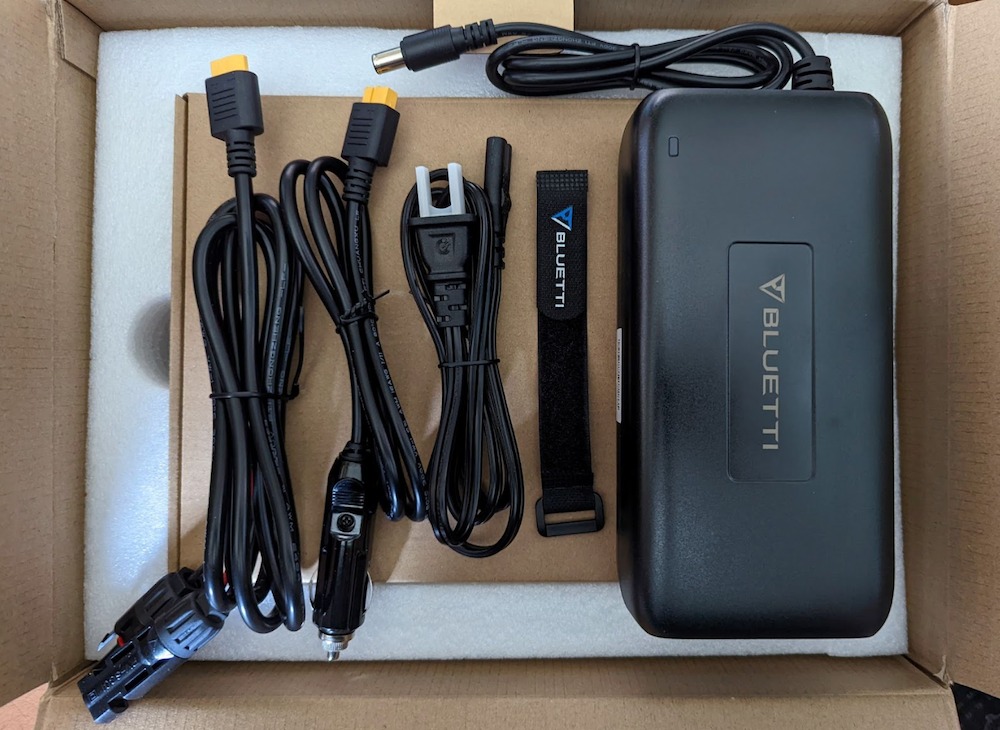
Inside the box, the EB55 comes with an AC power supply, a cable for charging from a vehicle’s DC outlet, and a cable for charging from solar panels. The EB55 has 12 outlets:
Four USB-A
One USB-C
Two grounded and two ungrounded 120V AC outputs
Two 12V/10A DC
One 12V DC "cigarette lighter" outlet
The unit is a compact 10.94 x 7.87 x 7.79 inches and weighs in at 16.5 lbs, with a foldable carrying handle on top. There is a built-in cooling fan with vents on the side of the unit, and a small backlit LCD screen on the front that displays the state of charge and input/output wattage using two shades of blue.
Charging
The Bluetti EB55 can charge from AC power with the included power brick, DC power from the solar panels, or both at the same time. It can also be charged using a 12V DC output from a vehicle or from a generator. Charging power is up to 200W from AC or solar, or 400W from both AC and solar at the same time.
In our tests, Bluetti’s 120W solar panel delivered its maximum power to the EB55 effortlessly under full sun on a warm day. The solar panel is about 2 feet high by 6 feet wide, with four sections that fold out from the stored position. On the back of these sections are thin “legs” that fold away from the main body and allow the user to adjust the angle at which the panel is placed relative to the ground, between 40° and 50°.
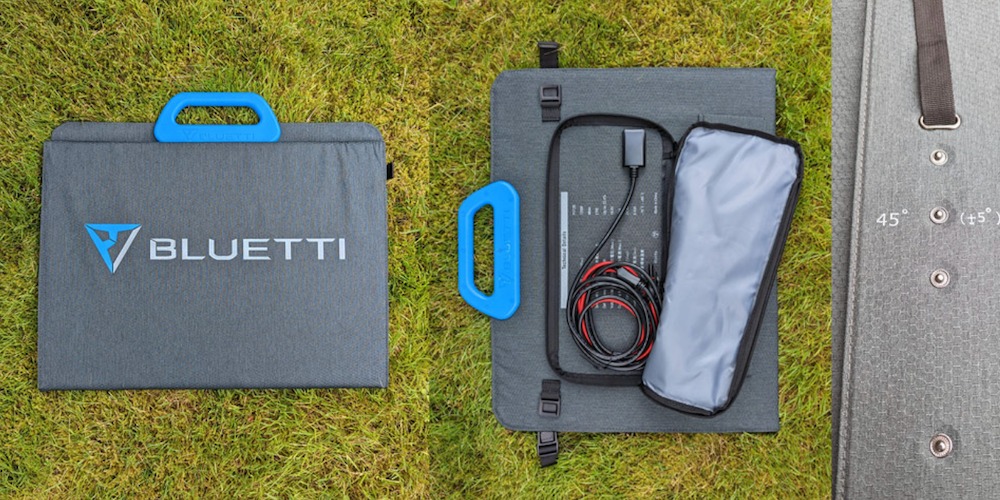
The whole solar panel is clad in ripstop-style polyester fabric, with a hard plastic handle at one end that is used for carrying the panel when it’s folded up. The solar sections themselves are laminated inside Ethylene tetrafluoroethylene (ETFE) sheets, which allows them to be flexible and resist fading and cracking due to high temperatures and UV radiation. A zippered pouch on the back of one section contains the cables and a list of specifications.
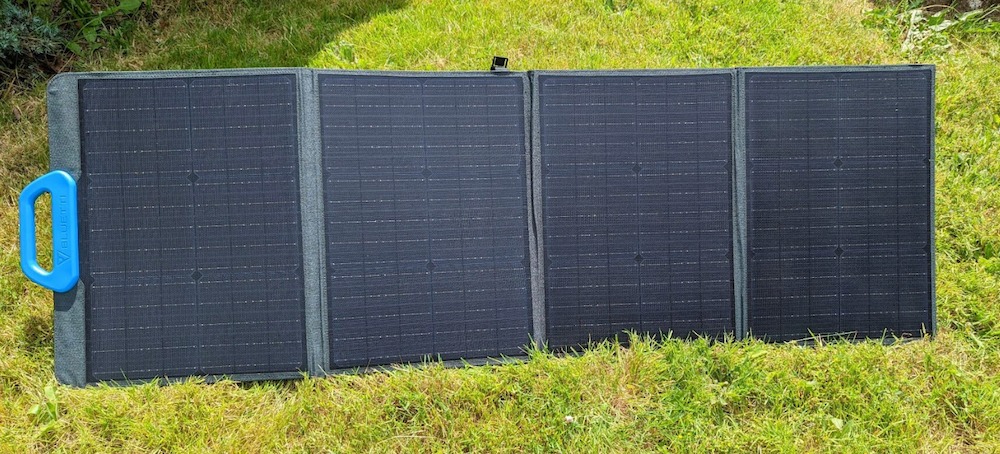
We’d recommend keeping the battery out of full sun because it heats up when charging.
Thankfully, the EB55 comes with a 5.5-foot solar charging cable with MC4 connectors, and the PV120 panel comes with its own 9.5-foot cable, making it easy to place the panel in the sun and the battery somewhere nearby in the shade. And because Bluetti uses standard solar connectors, additional cables can be purchased online from a variety of sources if you need more than 15 feet between the panel and the battery.
A word of caution: Bluetti solar panels are IP65 rated, meaning they can handle a little splash of water, but can’t withstand rain and snow. Only put them out on a dry day.
In testing the AC charging, we easily got the promised 200W from the charger, although it should be noted that the charging brick has its own internal cooling fan that can get a little noisy, so it’s best to charge it out of earshot. Either the AC adapter or the solar input is capable of filling the EB55’s 537 Wh of storage in about 3 hours from empty, and combining solar and AC together can increase the power to 400W, decreasing charging time down to just 1.8 hours.
Using Power
In our tests, the EB55 was capable of powering many important appliances and devices, and we recommend it for medium-light duty applications like phone and laptop charging, camping, or even for short-duration events like small concerts in the park where no power is available.
We tested our EB55 in a few ways: powering a small outdoor pool pump, running live sound through a PA speaker, and running a full-size refrigerator. In all these tests, the EB55 performed very well.
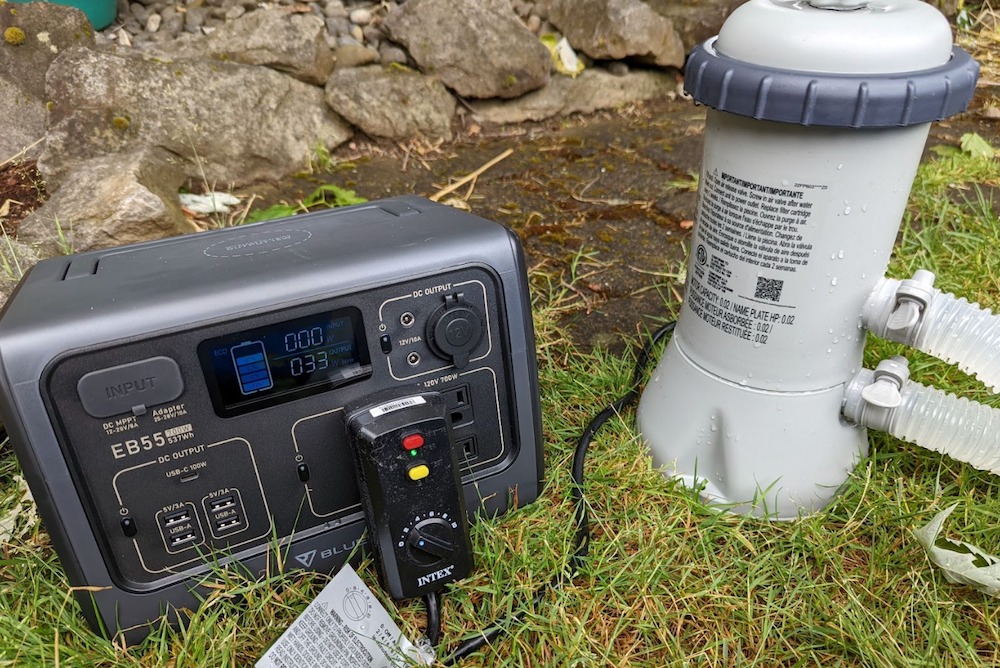
With its 537 Wh of battery capacity, it could theoretically run the 33W pool pump for 16 hours, even without solar recharging. At medium volumes, the PA speaker and some guitar pedals used 25W. Imagine an afternoon pool party with a rock band at a remote location run entirely by one Bluetti EB55 battery. All you’d need is transportation and a water source.
Closer to home, the refrigerator drew between 105W and 220W, depending on the cycle it was running, so it could be kept running for 3 hours or more during a power outage. If you add 4 hours of solar charging at an average of around 100W, you could extend that time to six hours or more. By plugging in the fridge only sporadically, you could theoretically keep food cold for days during a power outage using a single EB55 and solar panel, and probably have enough energy left over to keep your phone topped off.
Because of its LiFePO4 battery cell chemistry, the Bluetti should be able to fully charge and discharge 2,500 times, which could mean several years of power even with twice daily cycling. That many cycles should still leave the battery at 80% of its original capacity.
It’s a pretty remarkable little battery, and well worth its $499 MSRP. But the EB55 is one of the smallest capacity batteries Bluetti offers, and some of the company’s products can do much more than keep your food cold for a few hours.
Bluetti AC180 portable power station
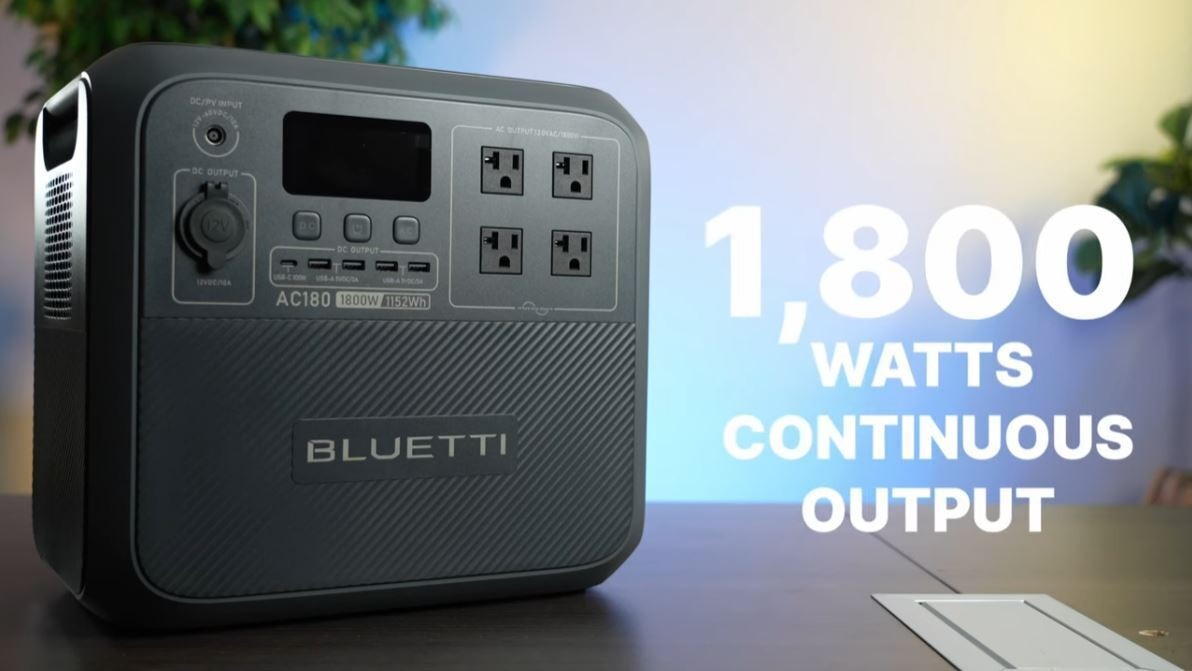
The Bluetti AC180 is a very capable portable power station. At 35.6 lbs, it comes in a little heavier than Bluetti says on their website (32.6 lbs), but it’s still easy enough for an adult to grab and put in a vehicle.
With 1,152 Wh capacity and a continuous power output of 1,800 W, it can run basically all standard small appliances like coffee makers, hair dryers, microwaves, and space heaters. It can also act as an uninterruptible power supply to keep essential devices like modems, desktop computers, and CPAP machines running in the event of an outage.
In our testing, the AC180 had no problem heating up a tea kettle in under 4 minutes, heating food in a microwave, and playing video games on a Nintendo Switch and LED TV.
For the needs of a small family in a remote off-grid cabin or a solar powered tiny house, the AC180 should have no problem meeting most needs for a weekend, especially if you bring one of Bluetti’s solar panels along for the trip.
Bluetti AC300+B300 combo
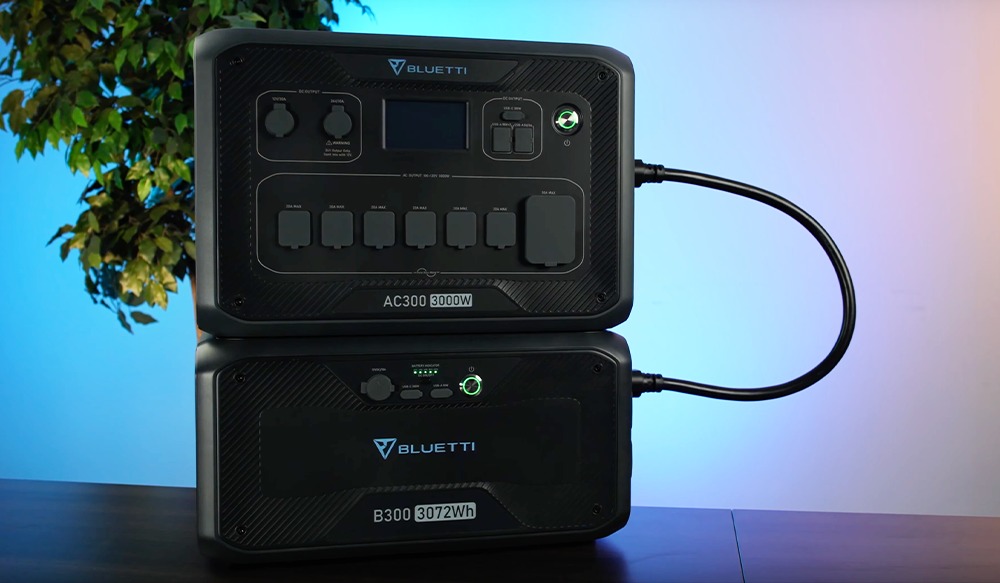
The Bluetti AC300+B300 combo is one of our favorite power stations. In fact, we gave it the top spot in our ranking of the best solar generators!
This combo is made of two separate pieces: the AC300 inverter module and the B300 battery module. Up to four B300 batteries can be connected to a single AC300, for a total of 12.29 kWh of storage. That’s almost as much as the Tesla Powerwall.
At 132 lbs (48 for the inverter and 84 for the battery), the AC300+B300 combo pushed the limits of what we’d consider “portable,” but it can work well for people who need a lot of power and storage for their RV or off-grid cabin.
In our tests, this combo with its 3,000W output handled pretty much everything we threw at it, from microwaves to induction cooktops, to small air conditioners. Its UPS features four different modes so you can set whether you want the UPS to engage at a certain time of day, or when there’s incoming solar power and the battery is fully charged.
Speaking of solar input, the AC300 can handle up to 3,600W of solar through its two built-in MPPT charge controllers. That amount of solar wattage can recharge a B300 battery in about an hour, so you can conceivably use this in an off-grid setting and get several times its capacity in output over the course of a sunny day.
One of the coolest features of the AC300 is the ability to do home backup of 240V loads. By using Bluetti’s split-phase 240V home integration kit, you can set up two AC300 units in parallel (with at least one B300 battery each) and output 240V at up to 30 amps.
Bluetti SwapSolar kit: AC180T and MultiCooler review
Bluetti’s latest products are actually part of a new product ecosystem called SwapSolar. The idea is based on the concept of swappable batteries that can be charged inside a portable generator and then used in separate appliances like the new MultiCooler portable refrigerator/ice-maker combo.
We actually tested out the SwapSolar combo. Here’s our video review of how it went:
The first generator in the new lineup is the AC180T. It comes with two swappable B70 batteries inside and is being sold alongside the MultiCooler now through Bluetti’s latest Indiegogo campaign.
Bluetti is offering Super Early Bird pricing of 35% off the set, or $1,429 for both the AC180T and MultiCooler, among other deals. Extra B70 battery packs sell for a retail price of $429, which is just 60 cents per watt-hour, allowing you to expand your total energy storage for less than the purchase price of a second AC180T.
How SwapSolar works
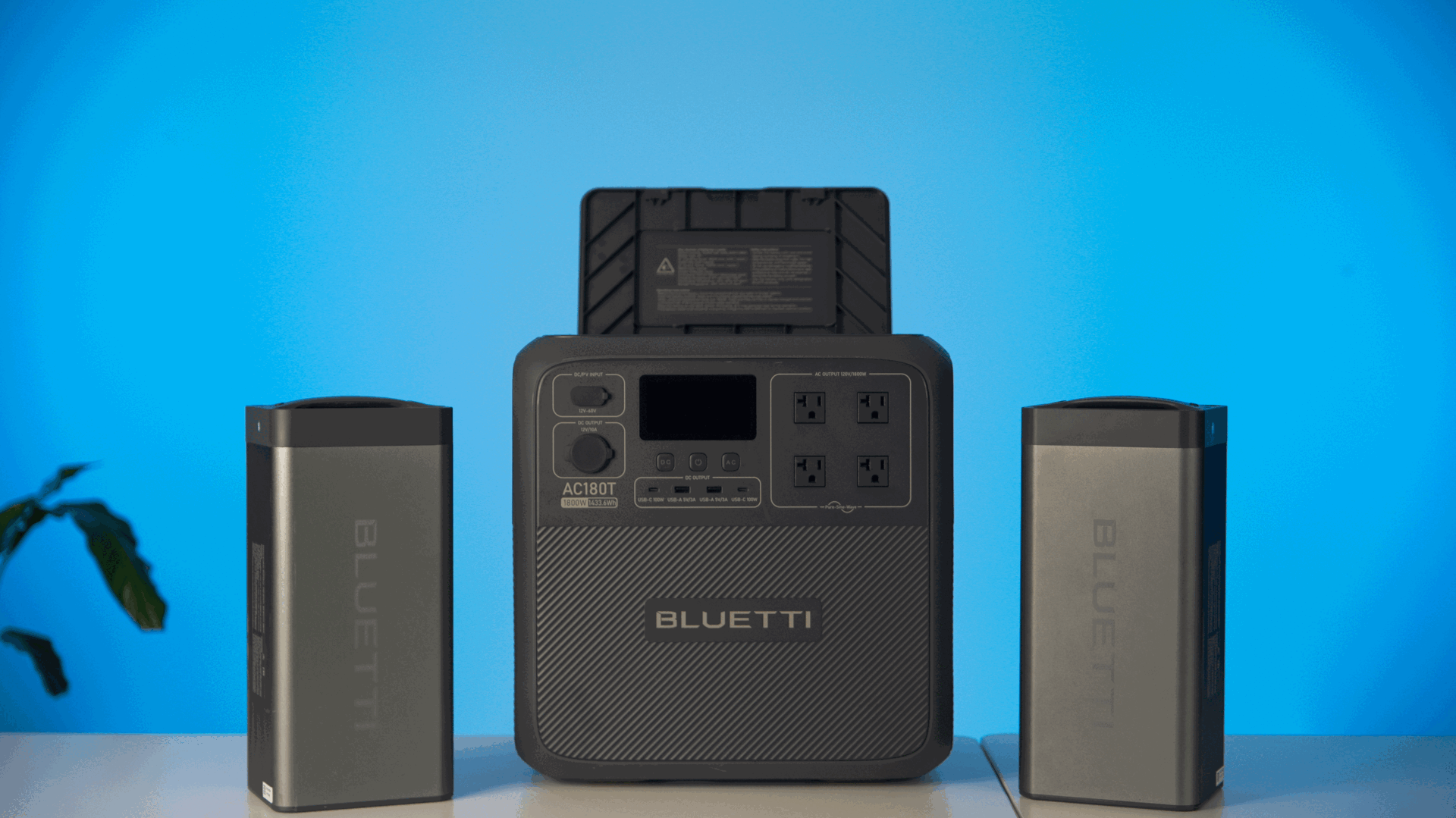
The benefits of the Bluetti SwapSolar setup are high power output, portability, expandability, and future-proofing. The first generator in the new lineup is the AC180T. It comes with two swappable B70 batteries inside and is being sold alongside the MultiCooler.
The AC180T boasts 1,200W of continuous output with one battery or 1,800W with two, which is enough to power most household appliances and electronics. The maximum output can be pushed to 2,700 W via “Power Lifting” mode for things like space heaters and electric tea kettles.
The AC180T is ultra-portable, because the batteries can be removed for transportation, leaving the empty united weighing just 25 pounds for easy carrying. Each B70 battery weighs 19 pounds and has a robust handle on top, making it simple to “swap” them when necessary.
When a battery is swapped, the AC180T keeps working as long as it has one battery installed, providing continuous power to your devices. The only current use for these batteries is to power the MultiCooler, but you can also set full batteries aside as extra energy storage. Future uses for the B70 could include powering trolling motors for fishing or power outposts for camping.
Future uses. Though the only current use for these batteries is to power the MultiColler, you can set full batteries aside as extra storage. Future uses for the B70 could include running trolling motors for fishing or power outposts for camping. These deep cycle batteries are meant for long-term storage and repeated charging, so they aren’t ideal for things like e-bikes or scooters, but don’t be surprised if a future iteration of this design is adapted for those uses.
Future uses. Though the only current use for these batteries is to power the MultiColler, you can set full batteries aside as extra storage. Future uses for the B70 could include running trolling motors for fishing or power outposts for camping. These deep-cycle batteries are meant for long-term storage and repeated charging, so they aren’t ideal for things like e-bikes or scooters, but don’t be surprised if a future iteration of this design is adapted for those uses.
Bluetti product comparison
Now let's look at some of the key specifications of Bluetti's product lineup. The company has offerings as small as the entry-level EB3A with a 268 Wh battery pack and as large as the expandable AC300 inverter module, which doesn't come with its own battery but can instead be paired with up to four B300 expansion batteries for 12.3 kWh of storage. That's nearly as large as a Tesla Powerwall.
The smaller, more portable power stations (basically anything that will fit in Bluetti's carrying case) are fairly simple; just boxes with batteries, inputs, and output ports, while the larger offerings like the Bluetti AC200MAX and AC300 come with Bluetooth and can be controlled via the Bluetti smartphone app (the newer, small EB3A is also app-enabled). For very large battery backup needs, two AC300 inverter modules can be paired with Bluetti's AC300 Fusion Box for a 240V system with up to 24.5 kWh of storage.
Here’s a rundown of a selection of Bluetti’s portable models and their key specs:
Product | Capacity | Output (surge) | Max input W | Number of outlets | Price |
|---|---|---|---|---|---|
EB3A | 268 Wh | 600W (1,200W) | 430W Solar+AC | 9 | |
EB55 | 537 Wh | 700W (1,400W) | 400W Solar+AC | 12 | |
AC180 | 1,152 Wh | 1,800W (2,700W power lifting) | 1,440W Solar+AC | 11 | |
AC300+B300 | 3,072 Wh | 3,000W (6,000W) | 5,400W Solar+AC | 16 |
Cost
Like a lot of technology products you can find on Amazon, Bluetti products often go on sale, and people looking for the company’s products can often find coupons and discount codes online. For reference, here are the MSRPs of the most popular Bluetti products:
EB3A: $299
EB55: $499
EB70S: $599
AC200P: $1,699
AC300 inverter module: $1,899
AC200MAX: $1,899
B230 expansion battery: $1,399
B300 expansion battery: $2,199
PV120 solar panel: $299
PV200 solar panel: $499
PV350 solar panel: $849
Bluetti battery warranties
The warranty is where portable batteries like Bluetti falter a bit compared to purpose-built home solar batteries. The warranty for most Bluetti products covers just 24 months of defects due to materials and workmanship. These products are designed to last for a long time, but the manufacturer doesn’t offer long-term coverage for most of its products.
That said, if you spring for the AC300 with one or more B300 expansion batteries, Bluetti offers 48 months of warranty coverage. Larger home battery backup systems like the EP500Pro come with 5-year warranties. These don't quite match the 10-year warranties offered by companies like Generac and LG, so if you're concerned about long-term coverage, one of those battery solutions might be better for you.
Ironically, Generac and LG use lithium NMC batteries, so the Bluetti should theoretically outlast them. Bluetti says its EB-series batteries will last for 2,500 cycles before being reduced to 80% of their original capacity, and its AC- and B-series batteries get estimates of 3,500 cycles before hitting 80%. Assuming one full cycle per day, that’s over 9 years.
How does Bluetti compare to the competition?
When it comes to the best solar generators, Bluetti is among the top contenders. Its LFP battery cells are rated to last five times as long as products from main competitors Jackery and GoalZero, and its products are every bit as durable and easy to use.
With 48-60 month warranties on its flagship products, Bluetti exceeds the standards set by its competitors, which almost all offer only 24 months of coverage. To be fair, their 500-cycle lifespans will almost certainly be up within those 24 months of regular usage, so Bluetti has a chance to extend its warranties and further set itself apart from Jackery, GoalZero, and others. We hope to see that as Bluetti products spend more time in the wild and prove their durability.
Which Bluetti product is right for you?
If you're on the go and need to keep small appliances powered in an off-grid situation, the EB55 is an excellent choice. If you just want to keep your phone charged in the wilderness, the new EB3A is a great, inexpensive option.
For longer trips and cabin stays, the AC200P provides a robust amount of energy storage and power output that could keep an off-grid cabin very comfortable, especially when paired with a few Bluetti solar panels wired in series.
For home backup applications, we recommend the EP500 Pro over the AC300 with expansion batteries, simply because of the form factor and the 5-year warranty. If Bluetti ever increases its warranty protection for its modular batteries, we'll update that recommendation accordingly.
Bottom line: are Bluetti products good?
Bluetti's batteries and solar panels compare favorably with the majority of other portable solutions on the market. The LFP batteries and ETFE-clad solar panels are powerful and well-built products designed for a life lived outside of the boundaries of the electric grid. On top of that, Bluetti meets or exceeds industry standards for portable devices with 2-5 year warranties on its products.
One caveat here is that the company is still only a few years old, and it remains to be seen whether its batteries will match the estimated 2,500-cycle lifespans, and whether the company will prove adept at handling customer complaints if they don't. But the tech is solid, the products are proving popular and well-liked, and Bluetti reps actively engage customers through multiple channels, including an owners' Facebook group. The company seems to be doing things right.
Another caveat is that Bluetti's solar panels aren't as robust as actual home solar panels. For example, they aren't designed to be outside in the rain and snow. If you're looking for something to act as a fixture on your home or even off-grid cabin, real roof- or ground-mounted solar panels are much more robust, and can survive the weather for decades. And you can still use Bluetti battery backup with a well-designed solar installation.

Regardless of the caveats, Bluetti is making some great products. If you’re looking for a way to keep important devices powered up while in the wilderness, Bluetti batteries and solar panels have our recommendation.
Ben Zientara is a writer, researcher, and solar policy analyst who has written about the residential solar industry, the electric grid, and state utility policy since 2013. His early work included leading the team that produced the annual State Solar Power Rankings Report for the Solar Power Rocks website from 2015 to 2020. The rankings were utilized and referenced by a diverse mix of policymakers, advocacy groups, and media including The Center...
Learn more about Ben Zientara